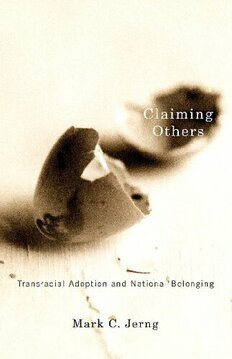
Claiming Others: Transracial Adoption and National Belonging PDF
Preview Claiming Others: Transracial Adoption and National Belonging
C L A I M I N G O T H E R S This page intentionally left blank C L A I M I N G O T H E R S Transracial Adoption and National Belonging Mark C. Jerng University of Minnesota Press Minneapolis London Portions of chapter 3 were previously published as “The Character of Race: Adoption and Individuation in William Faulkner’s Light in August and Charles Chesnutt’s The Quarry,” Arizona Quarterly 64, no. 4 (2008); reprinted by permission of the Regents of the University of Arizona. Portions of chapter 5 were previously published as “Recognizing the TransracialAdoptee:AdoptionLifeStoriesandChange-raeLee’sAGesture Life,”MELUS:JournaloftheSocietyfortheStudyofMulti-EthnicLiteratureof theUnitedStates31,no.2(Summer2006):41–67;reprintedbypermission ofMELUS. Copyright2010bytheRegentsoftheUniversityofMinnesota All rights reserved. No part of this publication may be reproduced, stored in a retrieval system, or transmitted, in any form or by any means, electronic, mechanical, photocopying, recording, or otherwise, without the priorwrittenpermissionofthepublisher. PublishedbytheUniversityofMinnesotaPress 111ThirdAvenueSouth,Suite290 Minneapolis,MN55401–2520 http://www.upress.umn.edu LibraryofCongressCataloging-in-PublicationData Jerng,MarkC. Claimingothers:transracialadoptionandnationalbelonging/ MarkC.Jerng. p. cm. Includesbibliographicalreferencesandindex. ISBN978-0-8166-6958-5(hc:alk.paper)– ISBN978-0-8166-6959-2(pb:alk.paper) 1.Americanliterature–20thcentury–Historyandcriticism. 2.Interracialadoptioninliterature. 3.Adoptioninliterature. 4.Raceinliterature. 5.Interracialadoption. I.Title. PS228.I69J472010 810.9(cid:2)35254–dc22 2010031953 PrintedintheUnitedStatesofAmericaonacid-freepaper TheUniversityofMinnesotaisanequal-opportunityeducatorandemployer. 16 15 14 13 12 11 10 10 9 8 7 6 5 4 3 2 1 Contents Introduction Transracial Adoption and the Reproduction of Personhood vii I. ON THE BORDERS OF KINSHIP 1. Competing Logics of Possession Unredeemed Captives in the 1820s 3 2. Unmanageable Attachments Slavery, Abolition, and the Transformation of Kinship 45 3. The Character of Race Individuation and the Institutionalization of Adoption 85 II. BETWEEN RIGHTS AND NEEDS 4. The Right to Belong Legal Norms, Cultural Origins, and Adoptee Identity 125 5. Resisting Recognition Narrating Transracial Adoptees as Subjects 168 6. Making Family “Look like Real” Transracial Adoption and the Challenge to Family 209 Acknowledgments 245 Notes 249 Index 293 This page intentionally left blank Introduction Transracial Adoption and the Reproduction of Personhood Adoptionasanactthatseversalllegaltiesbetweenachildand its biological parents is a fairly recent legal concept. The 1851 Massachusetts statute that formed the precedent and basis for ourmodernunderstandingofadoptionspecificallybrokefrom English jurisprudence, which held the child–biological parent bond inalienable “by any act of the parents themselves”1 and “prohibitedtheabsolute,permanent,andvoluntarytransferof parental power to third persons.”2 While this legal statute was passed with surprisingly little comment at the time, its effects have been far-reaching. Legally, this construction of adoption would gain legitimacy through the nineteenth and twenti- eth centuries, becoming an international phenomenon today. Socially,thedevelopmentofadoptionhasraisedissuesaround our political frameworks of family, nationality, and race and has sparked off controversial debates over privacy and secrecy, statewelfare,children’srights,andinternationalhumanrights. But perhaps most important, this formalization of adoption displacesthecentralityofbirthforourunderstandingsofwho we are in ways that we have yet to fully understand. Persons adoptedwithinthismodernconceptionchallengefundamental expectations and assumptions about personhood because they highlight the ways that birth situates the origins, continuities, genealogies, and histories that provide the conditions for leg- ibility within political society. Adoption in this sense assumes vii viii / Introduction that adopted persons will change identity—they will take on a new name, become part of a new family and sometimes a new country. And yet the precise parameters of this shift in the social standings of adopted persons have been unclear, contested, and negotiated in ways that reveal the interrelated construction of the categories of family, nation, and race. In his short play Trying to Find Chinatown, David Henry Hwangcomicallydramatizespreciselythisquestionofwhether adoptees can change social identities. The play depicts a white man, Benjamin, who is adopted by Chinese American par- ents from the Midwest. Having fully assumed the cultural and racialidentityofhisadoptedfamily,Benjaminissearchingfor his “roots” in Chinatown. He asks a Chinese American street musician, Ronnie, where he could find Chinatown. A series of comic misunderstandings ensues built around the inability of each person to fulfill the other’s expectations. Ronnie takes Benjamin as a racist white man who is exoticizing and objec- tifying him as a Chinatown tour guide (ronnie: “So why is it that you picked me, of all the street musicians in the City, to point you in the direction of Chinatown?”).3 Benjamin then confuses Ronnie by answering back with his vocabulary of antiorientalism and his knowledge of Asian American studies. Benjamin talks about taking “pride in my ancestors who built the railroads” and exploring the “history of oppression which ismylegacy,”throwingRonnieintoafit(12).ThenBenjamin states that he understands Ronnie’s confusion and explains by saying that he was adopted: ronnie.Idon’tknowwhatkindofbullshitethnicstudiespro- gramthey’rerunningoverinWuss-consin,butdidtheybother toteachyouthatinordertofindyourAsian“roots,”it’sagood ideatofirstbeAsian? (Pause) benjamin.Areyouspeakingmetaphorically? Introduction / ix ronnie.No!Literally!Lookatyourskin! ... benjamin. You see, I was adopted by Chinese American parentsatbirth.So,clearly,I’manAsianAmerican— ronnie.Eventhoughyou’reblondandblue-eyed. benjamin. Well, you can’t judge my race by my genetic heri- tagealone. ronnie.Ifgenesdon’tdeterminerace,whatdoes? benjamin. Perhaps you’d prefer that I continue in denial, masqueradingasawhiteman?(12–13) BenjaminthentalksaboutgainingarealsenseofAsianAmer- icancommunitysteepedinthetraditionsofChinesemythand spirituality and accuses Ronnie of being one of those “self- hating assimilated Chinese Americans” (14). The play ends with Ronnie’s resistance to this cultural nationalist version of Chinese American identity and Benjamin immersing himself intothespirituallineageofhisadoptedforefathers.BothBen- jaminandRonnieclaimdistinctversionsofChineseAmerican identity in relation to the question of “birth.” Though Ben- jamin’sskiniswhite,hebelievesheisAsianAmericanbyvirtue of adoption and is seeking to gain the cultural, political, and geographical trappings of that identity. Ronnie has a strictly geneticist view of racial identity and yet does not have a cul- tural nationalist view of Asian American identity, seeking to expand conceptions of Chinese American culture by drawing fromabroadswathofculturalresourcesandreferences(Hen- drix,Armstrong,Urbaniak).Thisplayshowsthewayinwhich “birth” acts as a pivot around which personal, national, racial, and familial identities revolve. Hwang’s play is a comic send-up of our assumptions about what birth into a specific family, culture, or race entails.
